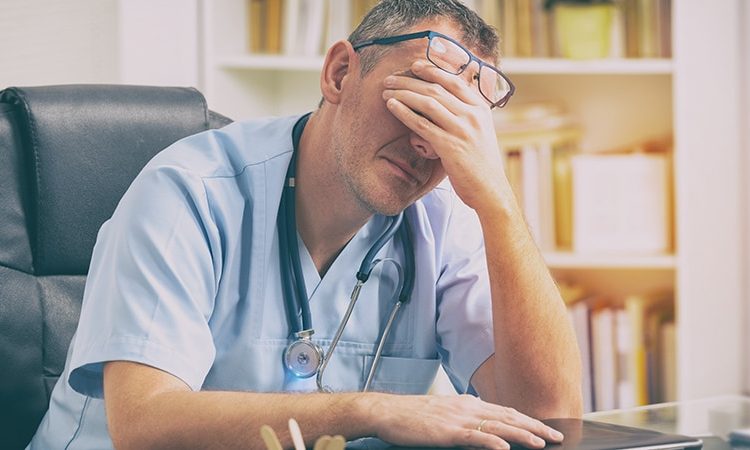Moral distress — a reaction to being unable to provide appropriate care or being forced into making questionable decisions — is common in oncology practice.
About 75% of the attendees at a recent session on the issue, held during the annual meeting of the American Society of Clinical Oncology (ASCO), said they had experienced moral distress in their clinical practice in the past 6 months.
When asked what do feel when they hear the phrase “moral distress,” the audience of oncologists and related healthcare professionals replied with such words as “tired,” “agony,” “panic,” “frozen,” “conflicted,” and “frustrated.”
Posing the questions was Jonathan M. Marron, MD, MPH, Dana-Farber/Boston Children’s Cancer and Blood Disorders Center, Boston, Massachusetts.
Marron defined moral distress as occurring when clinicians are prevented from taking “ethically appropriate actions” or are “forced to take actions that are ethically inappropriate,” resulting in a “sense of complicity in wrongdoing.”
It is not the same as emotional or psychological distress, moral injury or uncertainty, or compassion fatigue, he emphasized.
Moral distress occurs in relation to a specific event, but it leaves a “residue” that builds up over time, he commented.
Three Broad Categories
There are many sources of moral distress, which fit into three broad categories, noted
Ishwaria Mohan Subbiah, MD, MS, a medical oncologist at The University of Texas MD Anderson Cancer Center, Houston, Texas.
Patient-level moral distress may be the result of giving a treatment with low likelihood of benefit, or care not aligning with the patient’s best interests or wishes, whereas unit-level moral distress may arise from a lack of consensus over a treatment plan or its likelihood of benefit, or a lack of continuity of care.
Finally, system-level moral distress may derive from the inappropriate use of resources, or inadequate staffing or training to meet clinical needs.
Subbiah noted that moral distress has been described during end-of-life decision-making, at an incidence of up to 75% among physicians and nurses.
The common themes include false hope; delivery of care without adequate training, competency, and support, and suboptimal communication and a lack of consensus within the care team.
At this point during the session, Marron repeated his question to the audience of oncologists and related healthcare professionals: Based on what they had just heard, did they feel that they had experienced moral distress in their clinical practice in the past 6 months? The proportion agreeing with that statement had risen to 80%.
How Can It Be Measured?
The Measure of Moral Distress for Health Care Professionals attempts to capture all three levels of moral distress over a 6-month period, whereas the Moral Distress Thermometer aims to measure distress “in the moment,” the next speaker explained.
Elizabeth Epstein, PhD, RN, associate professor of nursing at the University of Virginia, Charlottesville, who was involved in developing the measure for healthcare professionals, emphasized that when moral distress occurs, it is important to “name the problem.”
It is important to discuss the issue within the team, in order to identify and map the distress, so that the people experiencing the distressing situation can be debriefed.
Organizations are becoming increasingly aware of the “complicated complications of moral distress” and the “dangers” not only for the organization “but also for their clinicians and for patients,” Epstein said.
As a result, more and more institutions are developing “moral distress consultation services,” she commented.
One example is the Moral Distress Consultation Collaborative that she and her colleagues developed, which currently includes seven organizations.
Another is a model for wellness and resilience, which is based around nine tactics for reducing distress, developed by Maria Magdalena Gonzalez, MPH, executive director of the Cancer Destination Service Line at Stanford Health Care, Stanford, California.
Tactics include acknowledging and assessing the problem, targeting interventions to improve efficiency, encouraging a collaborative community at work, and promoting flexibility and work–life integration.
Overall, the aim is to “recognize and acknowledge morally distressing situations” and have a “safe, even negotiating table” to allow the development of ways to remedy the causes of moral distress.
Gonzalez said that they have also devised a blueprint to improve physician well-being that includes foundational programs, efforts toward culture change, strategies for rapid iterative improvement, and procedures to ensure that programs are sustainable.
The result is a model of “professional fulfilment” based around creating a culture of wellness, practice efficiency, and developing personal resilience, with recurring themes that include having “meaning in work” and support, she said.
Wrapping up the session, Marron summarized four take-home messages.
The first is that that moral distress is a “unique but challenging entity in clinical practice.”
It is “common” in oncology practice and has “serious implications for all members of the multidisciplinary oncology team.”
The most important message, however, is that it is not a “you problem,” but instead is related to the system in which an individual works.
Finally, although there are strategies to help “navigate” moral distress, more work is needed, Marron concluded.
No funding source was declared. Marron reports relationships with Genzyme, Partner Therapeutics; Subbiah reports relationships (institutional) with MedImmune, AbbVie, Amgen, Bayer, Blueprint Medicines, Celgene, Exelixis, Fujifilm, GlaxoSmithKline, Incyte, Loxo, Multivir, NanoCarrier, Northwest Biotherapeutics, Novartis, Pfizer, Takeda, PharmaMar; Epstein and Gonzalez report no relevant financial relationships.
American Society of Clinical Oncology (ASCO) 2022 Annual Meeting. Presented June 5, 2022. Special Session on ‘Strategies to Address Moral Distress in Clinicians: What Should We Do When We Don’t Know What to Do?’
For more news, follow Medscape on Facebook, Twitter, Instagram, and YouTube
Source: Read Full Article
